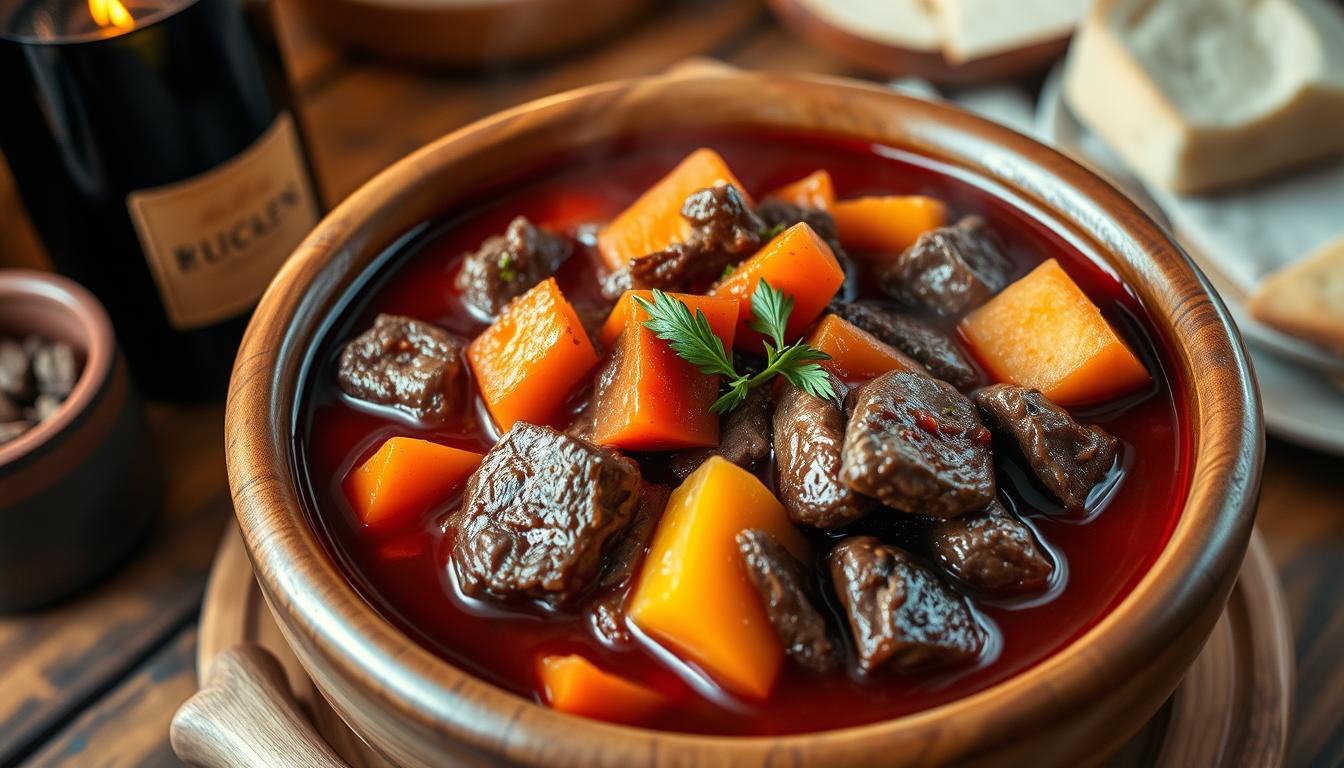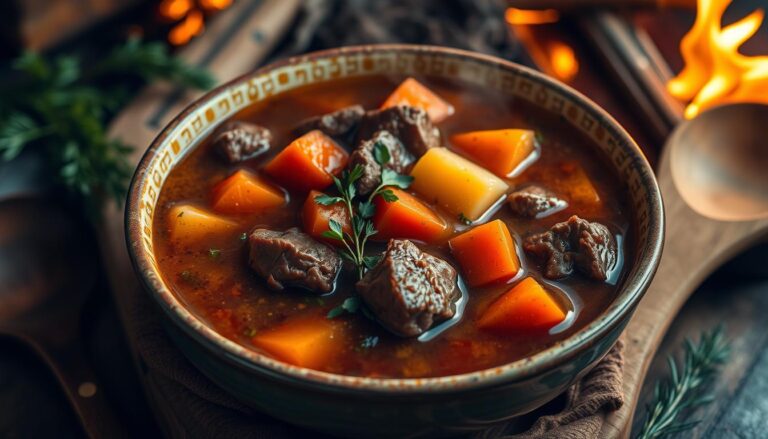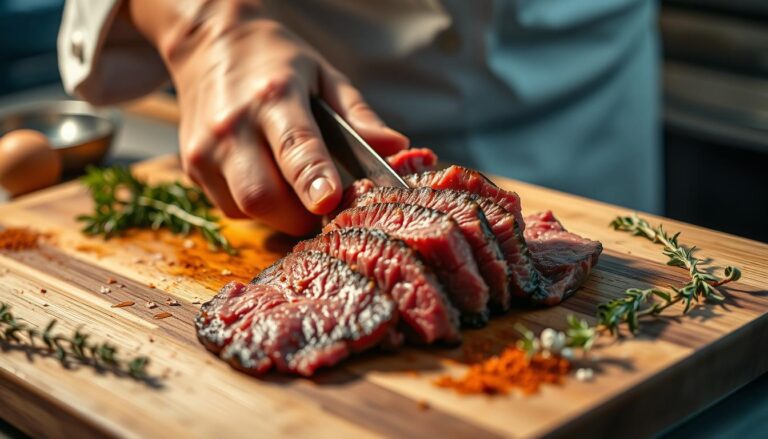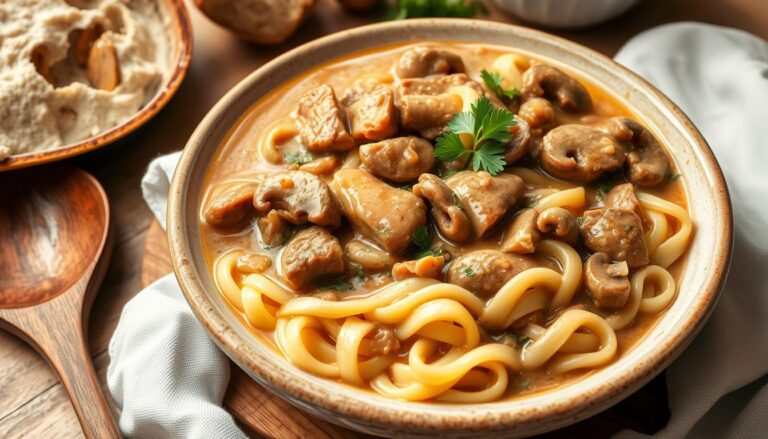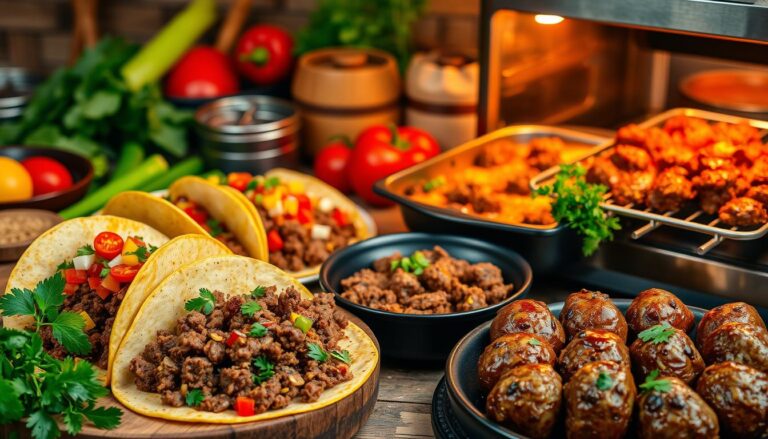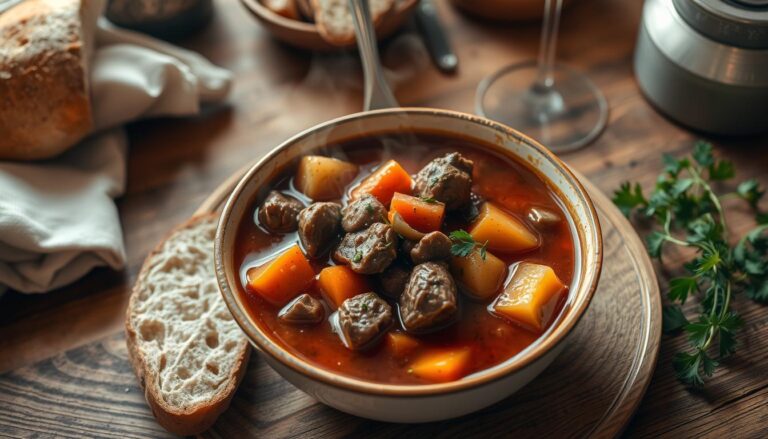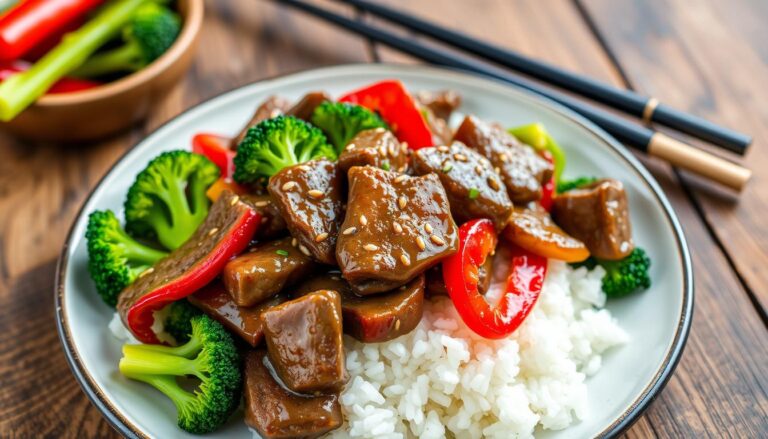Hearty Beef and Red Wine Stew: The Ultimate Comfort Meal
On a crisp autumn evening, nothing warms the soul like a bubbling pot of beef and red wine stew. The rich aroma fills the kitchen, bringing memories of family gatherings and cozy dinners. This classic French-inspired dish turns simple ingredients into a culinary masterpiece, earning thousands of 5-star reviews.
The best beef stew is more than just a meal. It’s a journey of flavors that transforms humble ingredients into a remarkable dining experience. A hearty beef stew recipe combines tender chunks of well-marbled beef chuck with a deeply flavored wine-based sauce. This promises comfort in every spoonful.
Table of Contents
Introduction to Beef and Red Wine Stew
A traditional beef stew is more than a meal. It’s a journey that warms the soul and connects families through its flavors. This stew turns simple ingredients into a taste sensation.
The dish’s roots go back to early 20th-century French cooking. August Escoffier created it in 1903. But Julia Child made it famous in American kitchens in 1963.
What Makes This Dish Special?
This stew is special because of its unique cooking and flavors. It has:
- Slow-cooking that makes meat tender
- Deep flavors from red wine
- It can be made in many ways
- It’s full of nutrients
“A great stew tells a story of patience, passion, and culinary craftsmanship.” – Chef’s Anonymous
A Meal for All Seasons
This stew is perfect for any time of year. It’s a warm comfort in winter and a fancy dinner in spring or summer.
It’s also very nutritious. A serving gives you:
- 712 calories
- 44g of protein
- 36g of carbohydrates
- Important vitamins and minerals
Whether you love cooking or just want a special meal, this stew is unforgettable. It mixes tradition with new ideas.
Ingredients Needed for the Perfect Stew
To make a great beef and red wine stew, pick the right ingredients. They should blend together for rich, complex flavors. The mix of proteins, veggies, and wine turns a simple stew into a memorable dish.
Essential Proteins and Vegetables
For a top-notch red wine stew, choose the best ingredients. Chuck roast is the best beef cut. It has lots of marbling for tender, flavorful meat.
- Beef Chuck Roast: 3 pounds, cut into 2-inch cubes
- Fresh Vegetables:
- Carrots
- Onions
- Celery
- Garlic cloves
- Seasonings:
- Dried thyme
- Bay leaves
- Fresh parsley
Choosing the Right Red Wine
Choosing the right wine is key for a great beef and red wine stew. Chefs say dry red wines add depth and complexity.
| Wine Variety | Flavor Profile | Recommended for Stew |
|---|---|---|
| Cabernet Sauvignon | Bold, full-bodied | Excellent |
| Pinot Noir | Light, elegant | Very Good |
| Cotes du Rhone | Balanced, medium-bodied | Great |
“The wine you cook with should be good enough to drink, but doesn’t need to be expensive.”
Pro tip: Always pick a wine you like to drink. The flavor will get stronger as it cooks, so quality is important.
Preparing the Beef for Stewing
Creating the best beef stew begins with picking the right meat and preparing it well. The key to a great stew is using high-quality beef. This beef will become tender and flavorful as it cooks.
Selecting the Best Cuts of Beef
Boneless chuck roast is the top choice for traditional beef stew. It has the right mix of meat and fat for a rich taste. Chefs advise against using lean “stew meat” because it can dry out quickly.
- Best beef cuts for stewing:
- Boneless chuck roast
- Rump roast
- Bottom round
Meat Preparation Techniques
Getting the meat ready is key for a top-notch stew. Cut the beef into 1.5-inch cubes. Remove big fat pieces but keep some for flavor. Dry the meat with paper towels to help it brown better.
| Preparation Step | Details |
|---|---|
| Cutting | 1.5-inch uniform cubes |
| Fat Removal | Remove large chunks, keep some for flavor |
| Drying | Pat meat with paper towels |
Marinating for Enhanced Flavor
Marinating is optional but can make your stew better. A mix of red wine, herbs, and spices adds depth and tenderness to the meat.
“The secret to a memorable stew lies in the preparation of the meat.” – Culinary Expert
Season the meat well with salt and pepper before cooking. This will help create a rich flavor that makes your stew unforgettable.
Cooking Techniques for Delicious Stew
Making an easy beef stew is all about mastering certain cooking techniques. These methods turn simple ingredients into a rich, tasty meal. The key is to know how to create deep, complex flavors through careful preparation and cooking.
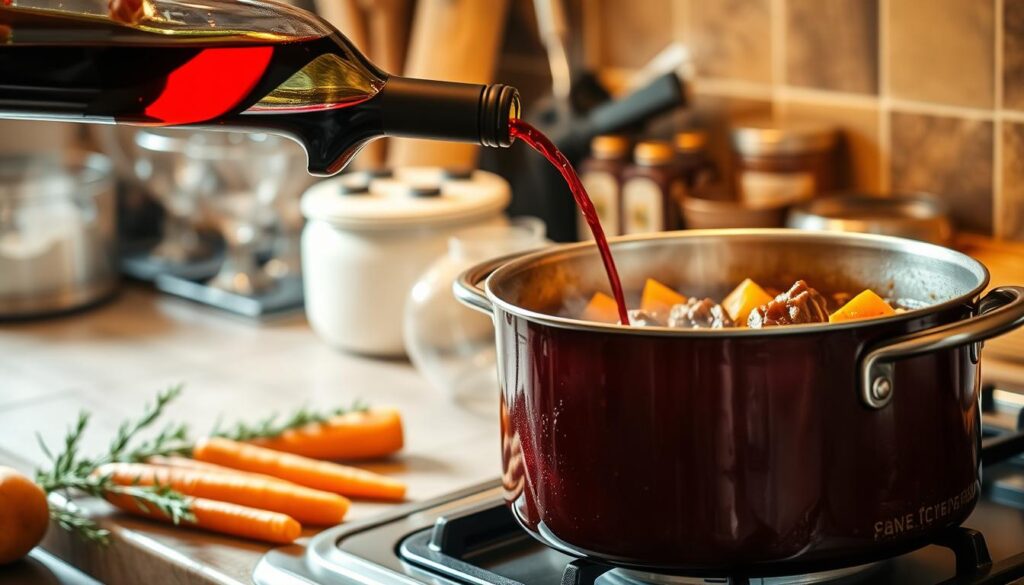
Mastering the Art of Browning Meat
Starting a delicious beef stew with proper meat browning is essential. This step lays the foundation for incredible flavors. Here are some tips from chefs:
- Use a heavy-bottomed pot or cast-iron Dutch oven
- Pat meat dry before searing
- Brown meat in small batches
- Maintain high heat to create a rich, caramelized exterior
Layering Flavors through Strategic Sautéing
The secret to a rich beef stew is layering flavors. Experts recommend a strategic sautéing approach to enhance taste.
| Ingredient | Sautéing Technique | Flavor Impact |
|---|---|---|
| Onions | Caramelize slowly | Adds sweetness |
| Garlic | Brief, high-heat sauté | Releases aromatic compounds |
| Tomato Paste | Cook with aromatics | Enhances umami flavor |
“The secret to an extraordinary stew is patience and understanding how flavors develop through careful cooking techniques.” – Culinary Expert
When making your easy beef stew, deglaze the pan with red wine or broth. This step captures all the flavorful browned bits. It makes your stew unforgettable.
The Role of Herbs and Spices
Making a tasty beef stew is more than just using good meat and veggies. The key to a great stew is choosing the right herbs and spices. They turn a simple dish into a true culinary delight.
Seasonings can make a beef stew go from good to amazing. Chefs know that herbs and spices are essential. They add depth and complexity to every bite.
Common Seasonings Used in Stews
Experts suggest a special mix of herbs and spices for a memorable stew:
- Thyme – adds earthy undertones
- Bay leaves – provide subtle aromatic notes
- Fresh parsley – brings brightness
- Garlic – creates a savory base
- Black pepper – adds warmth
- Kosher salt – enhances overall flavor
“Herbs are the soul of cooking. In a beef stew, they’re not just ingredients; they’re storytellers of flavor.” – Chef Kieron Hales
Fresh vs. Dried Herbs: What’s Best?
Choosing the right herbs is key for a hearty stew. Dried herbs like thyme are great for long cooking times, slowly releasing their flavors. Add fresh herbs like parsley at the end to keep their taste and color bright.
Some chefs suggest marinating beef with herbs for 24-36 hours before cooking. This method lets herbs like rosemary, thyme, and basil deeply flavor the meat. It makes for a memorable meal.
Simmering to Perfection
Making the best beef stew is all about slow cooking. It turns tough meat into tender, delicious food. This is done through careful simmering.
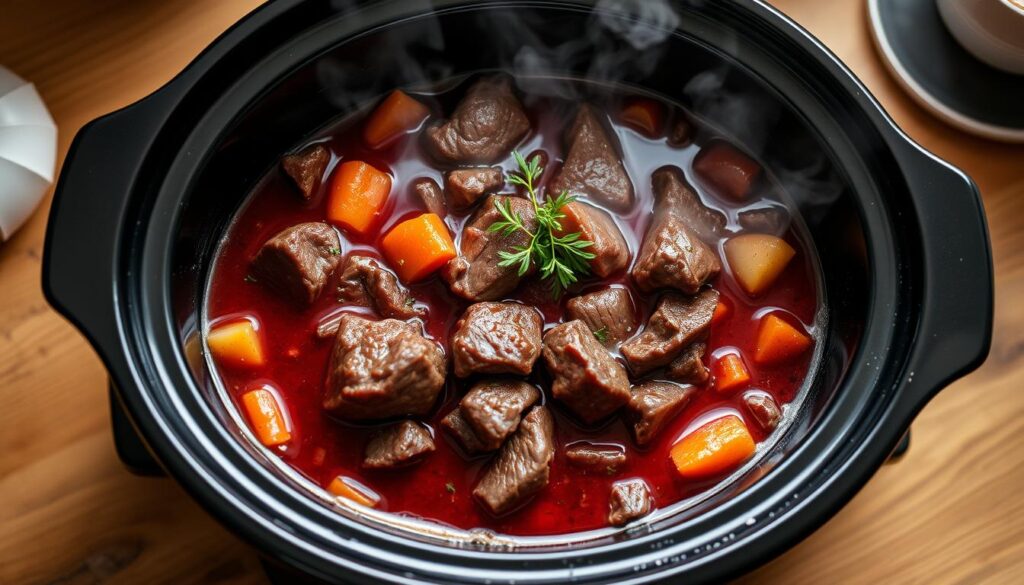
The secret to a great slow cooker beef stew is in the simmering process. Chefs know that time and temperature are key for deep flavors.
The Art of Low and Slow Cooking
Slow cooking breaks down meat fibers, making it tender. For the best stew, follow these tips:
- Keep the temperature low (around 300°F)
- Cover the pot to keep moisture and flavor in
- Stir now and then to avoid sticking
- Give meat enough time to get tender
Ideal Simmering Duration
The best simmering time for a rich stew is 2-3 hours. Here’s what you should do:
| Cooking Stage | Duration | Purpose |
|---|---|---|
| Initial Cooking | 2 hours | Tenderize meat |
| Vegetable Addition | 1 hour | Develop flavor complexity |
| Total Cooking Time | 3 hours | Complete flavor melding |
“Patience is the most important ingredient in creating a truly remarkable stew.” – Culinary Wisdom
For a standout slow cooker beef stew, give it enough time. Each hour makes the flavors richer and the meat tender. This turns a simple meal into a comforting, satisfying dish.
Serving Suggestions for the Perfect Meal
Making a delicious beef stew is an art. Serving it right can make the whole meal better. A traditional beef stew needs sides that match its rich flavors.
Accompaniments that Complement Stew
The right sides can make a hearty beef stew unforgettable. Here are some great choices:
- Crusty artisan bread for soaking up the savory sauce
- Creamy mashed potatoes as a luxurious base
- Buttered wide egg noodles for added texture
- Crisp green salad to balance the rich stew
Ideal Side Dishes to Serve
For wine lovers, pairing your stew is fun. Choose a full-bodied red wine like Cabernet Sauvignon or Syrah. A sprinkle of fresh parsley adds color and freshness.
“The perfect stew is not just about the recipe, but how you serve it.” – Culinary Experts
Pro tip: Let your traditional beef stew rest for a few minutes before serving. This lets the flavors settle, making the meal even more enjoyable.
Storing and Reheating Leftovers
Making a tasty easy beef stew is a big job. So, keeping leftovers fresh is key to enjoying it again. The right storage and reheating methods keep the flavors and meat tender.
Best Practices for Storing Stew
Here’s how to store your best beef stew:
- Cool the stew completely before storing
- Use airtight containers to prevent moisture loss
- Refrigerate for up to 5 days
- Freeze for maximum preservation up to 3 months
“The key to great leftovers is proper storage and gentle reheating.” – Professional Chef
Reheating Tips to Maintain Flavor
Reheating your stew needs careful steps to keep its taste and texture. The stovetop method is best for this.
- Choose medium-low heat for even warming
- Stir occasionally to prevent burning
- Add a splash of beef broth if the stew seems dry
- Avoid repeated reheating to maintain quality
Pro tip: Only reheat the portion you plan to consume to ensure maximum flavor and food safety.
Variations of Beef and Red Wine Stew
Trying new things with the classic red wine stew recipe can turn it into a fun journey. Traditional beef stew is a blank canvas for creativity. It lets you make it your own, whether you have special tastes or dietary needs.
Creative cooks can try new ingredients to make their stew taste amazing. Here are some cool ideas:
- Add earthy cremini mushrooms for depth
- Include sweet pearl onions for complexity
- Incorporate root vegetables like parsnips or turnips
- Experiment with different herb combinations
Dietary-Friendly Adaptations
For those with special dietary needs, the traditional beef stew can be easily changed:
- Gluten-free option: Use cornstarch instead of all-purpose flour
- Low-carb variation: Replace potatoes with cauliflower
- Non-alcoholic version: Substitute wine with beef broth and vinegar
Flavor Enhancement Techniques
Make your delicious beef stew even better with these ingredients:
| Ingredient | Flavor Impact |
|---|---|
| Pancetta | Adds rich, salty depth |
| Fresh rosemary | Introduces aromatic herbaceous notes |
| Sage | Provides earthy, warming undertones |
“A great stew is like a culinary canvas – always ready for your unique touch.”
When you’re trying new things, remember to keep an eye on nutrition. The red wine stew recipe can stay healthy while still being fun. Just remember, cooking times might change with new ingredients.
Conclusion: Enjoying Your Beef and Red Wine Stew
Making the best beef stew is more than a recipe. It’s about creating a special dining moment. This hearty stew brings families together, offering warmth and comfort.
The stew is a proof of slow cooking’s magic. It turns simple ingredients into a rich, flavorful dish. It’s also nutritious, with 330 calories and 30g of protein per serving. You can store leftovers in the fridge for up to 3 days or freeze them for later.
This dish is perfect for any occasion, from a weeknight dinner to a special event. It suits all tastes, thanks to its versatility. Every element, from the meat to the wine, makes it a memorable meal that celebrates home cooking.
The Comfort of Home-cooked Meals
A well-made stew is more than just food. It’s a cherished memory that connects generations. It turns simple ingredients into a special meal that honors family traditions.
Final Thoughts on Stews as Family Favorites
Enjoy making a meal that brings people together. Your beef and red wine stew is a celebration of flavor, comfort, and the joy of cooking at home.

